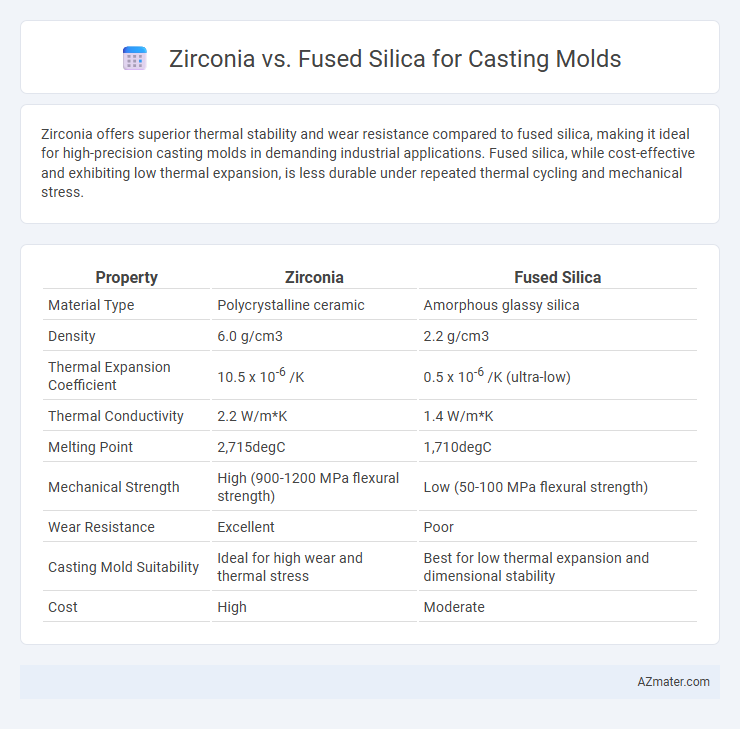Zirconia offers superior thermal stability and wear resistance compared to fused silica, making it ideal for high-precision casting molds in demanding industrial applications. Fused silica, while cost-effective and exhibiting low thermal expansion, is less durable under repeated thermal cycling and mechanical stress.
Table of Comparison
| Property | Zirconia | Fused Silica |
|---|---|---|
| Material Type | Polycrystalline ceramic | Amorphous glassy silica |
| Density | 6.0 g/cm3 | 2.2 g/cm3 |
| Thermal Expansion Coefficient | 10.5 x 10-6 /K | 0.5 x 10-6 /K (ultra-low) |
| Thermal Conductivity | 2.2 W/m*K | 1.4 W/m*K |
| Melting Point | 2,715degC | 1,710degC |
| Mechanical Strength | High (900-1200 MPa flexural strength) | Low (50-100 MPa flexural strength) |
| Wear Resistance | Excellent | Poor |
| Casting Mold Suitability | Ideal for high wear and thermal stress | Best for low thermal expansion and dimensional stability |
| Cost | High | Moderate |
Introduction to Casting Mold Materials
Zirconia and fused silica are prominent materials used in casting molds due to their high thermal stability and resistance to deformation under extreme temperatures. Zirconia offers superior mechanical strength and thermal shock resistance, making it ideal for precision casting applications requiring durability and repeatability. Fused silica features low thermal expansion and excellent insulation properties, which help in maintaining dimensional accuracy and minimizing defects in complex mold geometries.
Overview of Zirconia and Fused Silica
Zirconia offers superior thermal stability and higher melting points compared to fused silica, making it ideal for casting molds requiring durability under extreme temperatures. Fused silica provides excellent thermal shock resistance and low thermal expansion, which helps maintain structural integrity during rapid temperature changes in casting processes. Both materials serve critical roles in mold casting, with zirconia favored for high-performance applications and fused silica preferred for precision and thermal consistency.
Thermal Properties Comparison
Zirconia exhibits superior thermal stability with a melting point around 2700degC, significantly higher than fused silica's melting point near 1710degC, making it better suited for high-temperature casting molds. Zirconia also has a low thermal conductivity of approximately 2 W/m*K, allowing it to retain heat effectively, while fused silica's thermal conductivity is even lower at about 1.4 W/m*K, providing excellent thermal insulation but slower heat dissipation. The coefficient of thermal expansion for zirconia (~10.5 x 10^-6 /degC) is higher than fused silica (~0.5 x 10^-6 /degC), indicating fused silica offers superior dimensional stability under temperature changes during the casting process.
Mechanical Strength and Durability
Zirconia exhibits superior mechanical strength compared to fused silica, with high fracture toughness and resistance to crack propagation, making it ideal for casting molds subjected to heavy mechanical stress. Its excellent durability resists thermal shock and wear during repeated casting cycles, maintaining dimensional stability under high temperatures. Fused silica, while more thermally stable at extreme temperatures, lacks the toughness of zirconia and is more prone to brittle failure under mechanical loading, limiting its lifespan in high-stress casting applications.
Chemical Resistance and Stability
Zirconia exhibits superior chemical resistance and exceptional thermal stability in casting molds, maintaining integrity against acidic and alkaline environments up to temperatures around 2400degC. Fused silica offers excellent resistance to thermal shock and low thermal expansion but is more susceptible to degradation when exposed to alkaline substances over prolonged periods. The choice between zirconia and fused silica for casting molds depends on the specific chemical exposure and thermal conditions, with zirconia preferred for highly corrosive or high-temperature applications.
Surface Finish Quality
Zirconia molds provide superior surface finish quality due to their high hardness and thermal stability, resulting in smoother and more precise castings with less post-processing. Fused silica molds offer excellent thermal shock resistance and low thermal expansion, but typically yield a rougher surface finish compared to zirconia, requiring additional polishing. For applications demanding high-resolution detail and fine surface texture, zirconia is the preferred material over fused silica in casting molds.
Cost Analysis and Availability
Zirconia offers superior thermal stability and durability for casting molds but comes at a significantly higher cost compared to fused silica, which provides excellent thermal shock resistance at a more affordable price point. Fused silica is widely available and easier to source globally, making it a cost-effective choice for large-scale production, whereas zirconia, being less abundant and more specialized, may incur longer lead times and higher procurement expenses. Cost analysis favors fused silica for budget-conscious projects, while zirconia is preferred in applications demanding enhanced performance despite its premium price.
Application Suitability in Casting
Zirconia offers superior thermal shock resistance and higher melting point compared to fused silica, making it ideal for casting molds used in high-temperature metal casting applications such as aerospace and automotive industries. Fused silica provides excellent dimensional stability and low thermal expansion, suitable for precision casting where minimal deformation is crucial, like in jewelry and investment casting. Selecting between zirconia and fused silica depends on the required thermal endurance and mold life, with zirconia preferred for repeated high-heat cycles and fused silica favored for fine detail and surface finish.
Environmental Impact and Safety
Zirconia casting molds exhibit higher thermal stability and durability compared to fused silica, reducing waste through extended mold life in manufacturing processes. Fused silica, while less durable, offers lower embodied energy in production but poses risks of silica dust inhalation, necessitating stringent safety measures. Zirconia's inert nature minimizes environmental contamination, whereas fused silica's fine particulate matter requires advanced filtration systems to prevent occupational hazards and ecological impact.
Conclusion: Choosing the Right Mold Material
Zirconia offers superior thermal stability and wear resistance, making it ideal for high-temperature casting processes demanding precision and durability. Fused silica provides excellent thermal shock resistance and low thermal expansion, suitable for applications requiring dimensional stability and cost efficiency. Selecting the right mold material depends on balancing performance requirements with budget considerations, where zirconia excels in longevity and quality, while fused silica suits less demanding, cost-sensitive projects.

Infographic: Zirconia vs Fused silica for Casting mold
 azmater.com
azmater.com